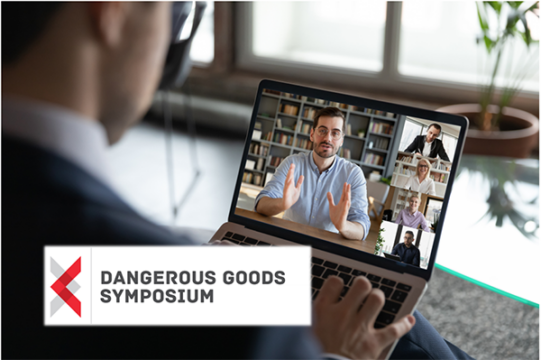
With a pastry and a cup of coffee on your desk, the first session of the 2020 Dangerous Goods Symposium felt a lot like previous years. Two regulatory experts were speaking, and trying to take in all the information they shared was like drinking from a firehose.
Of course, this year’s Symposium isn’t like other years, for obvious reasons. Instead of traveling to Chicago we’re experiencing the Symposium at the new DG Exchange. Nevertheless, yesterday’s first session—Regulatory Updates, Session 1—delivered the exact same level of information and insight as previous years’ openers.
It was a welcome splash of familiarity in a year that’s been alien and strange in so many ways.
Here’s a brief recap of what PHMSA’s Shane Kelly and Vinny Desiderio of the USPShad to share. (You can also watch the complete session here.)
PHMSA’s Shane Kelly: Making sure regulations aren’t an impediment
“Our vision is to be the most innovative transportation safety organization in the world,” said Kelly, who is Director, Standards and Rulemaking Division, at PHMSA’s Office of Hazardous Materials Safety. “So we focus on ensuring the regulations are not overly burdensome and finding ways to reduce costs through innovative solutions and opportunities.”
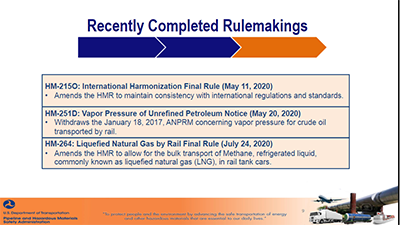
He cited HM-264 as an example. “LNG by rail is one of our major accomplishments. It’s a niche, but that can change over time and we want to make sure the regulations aren’t an impediment. We’re making sure we have open pathways for commerce while keeping the public safe and meeting our growing energy needs.”
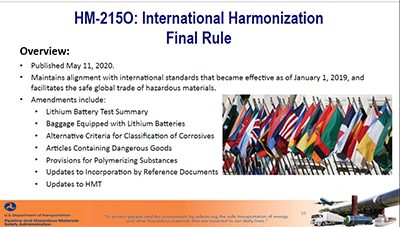
Another example: the sections of HM-215O on Articles Containing Dangerous Goods. “This took years, because we’re very good at liquids and solids, but articles are a different area. We’re making sure regulations don’t lag behind technology, and allowing for innovation that isn’t limited by the regulations.”
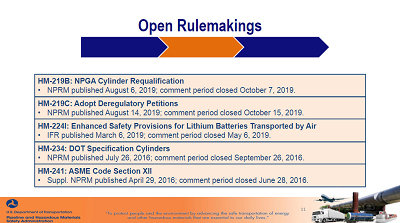
Discussing open rulemakings, he said, “HM-219C is one of my personal favorites. It draws from the petitions between 2015-18 reflecting the experience in the regulated community.” He described the sections that would permit the import of filled pi-marked foreign pressure receptacles as “recognizing that there are processes in place to ensure the vessels are maintained, while we eliminate the need for multilateral agreements.”
Kelly continually discussed the importance of petitions in PHMSA rulemaking.
“It’s Important to recognize that rulemaking is collaborative,” he said. “We need to lay out all the implications and impacts, and we are not best positioned as a government agency to do that. We need your help. All data is important to us. Even if it’s just sound bites when we brief OMB, never underestimate the value of the data you have.”
Vinny Desiderio: Enforcement and education
As Hazardous Materials Program Specialist with the U.S. Postal Inspection Service, Vinny Desiderio admits that “Enforcement is not an ideal way of getting information across.” Yet if that’s what it takes to keep postal workers and the public safe, that’s what they’ll do.
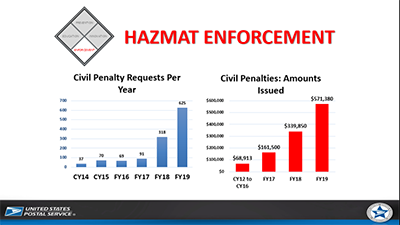
“We could exceed 1000 requests this year,” he said. “We want to prevent these things from happening, but when push comes to shove we’ll take action if someone’s putting our folks in danger.”
He described other methods—internal and external—of educating people about the dangers of mailing Dangerous Goods and preventing incidents.
Internally, the Postal Service has deployed three e-learning courses, covering topics such as the warning signs of improperly packaged or undeclared hazmat and recognizing if shippers are shipping hazmat and guiding them. Externally, they’ve focused on counter-messaging on social media, where people post videos on how to evade detection.
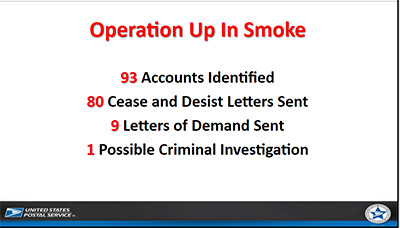
Still, his teams have to pursue enforcement out of necessity. He describes medium size shippers as the biggest challenge. “It’s very simple to set up an e-commerce business, and they don’t know or don’t care about regulations. It’s like the wild west. We’re putting out fires all the time—sometimes literally.”
Desiderio hears two consistent themes in his conversations with violators: “I saw that other people were doing it, and just thought it was okay” and—especially with lithium batteries—“I see my competitors doing it, so I have to do it, too.”
“We need to go to the root and attack these attitudes from the start,” he said. “We let people know that it isn’t okay.”
Coming up at the DG Symposium
Friday, Sept. 11: Compliance vs. Competence—Do You Know What You Don’t Know? Jade Eldridge, Advisor EHS–Hazards & Controls at Suncor, addresses the misconception that training equals competence and talks about ways to set a higher bar for hazmat training.
Sept. 14 -18: Lithium Battery Week. ‘Nuff said.
Make sure your shipments are safe and in complete compliance with a full line of solutions from Labelmaster—a full-service provider of goods and services for hazardous materials and Dangerous Goods professionals, shippers, transport operators and EH&S providers.

